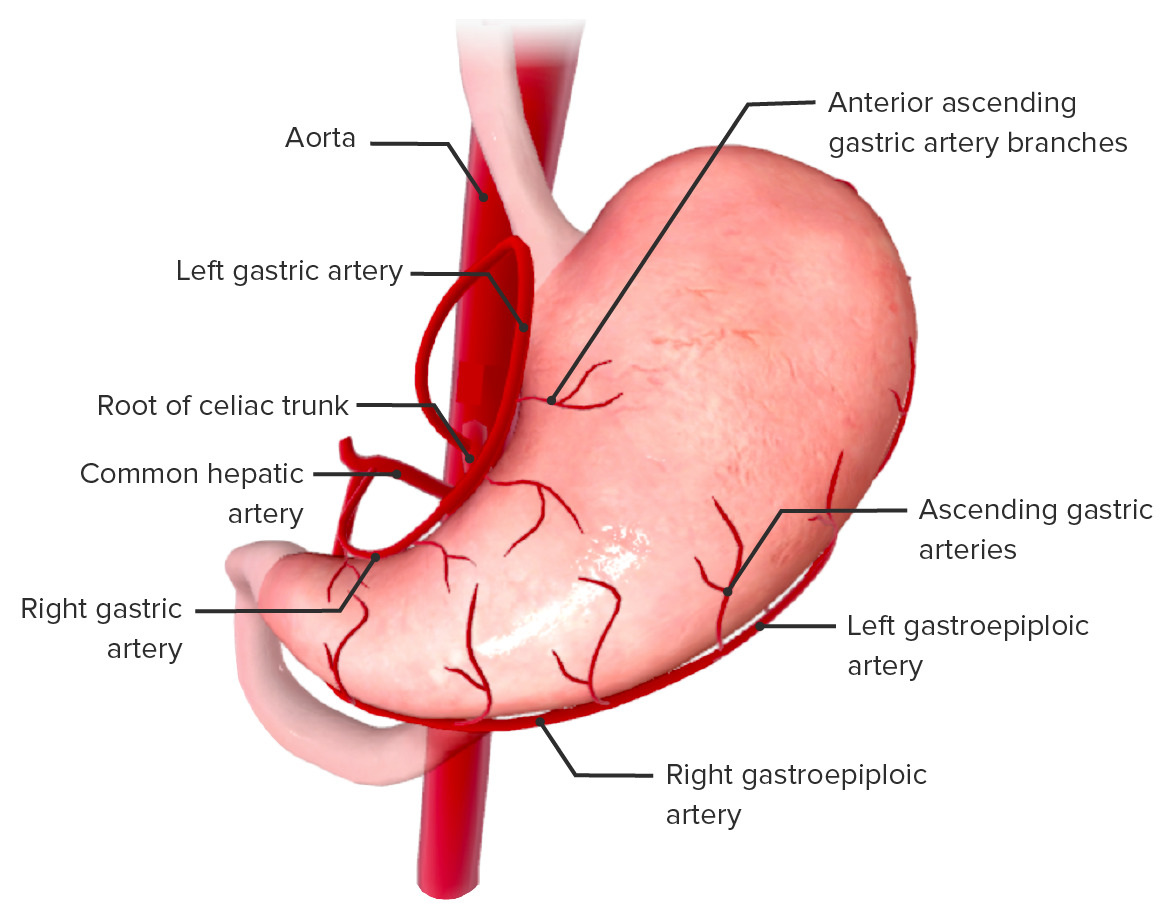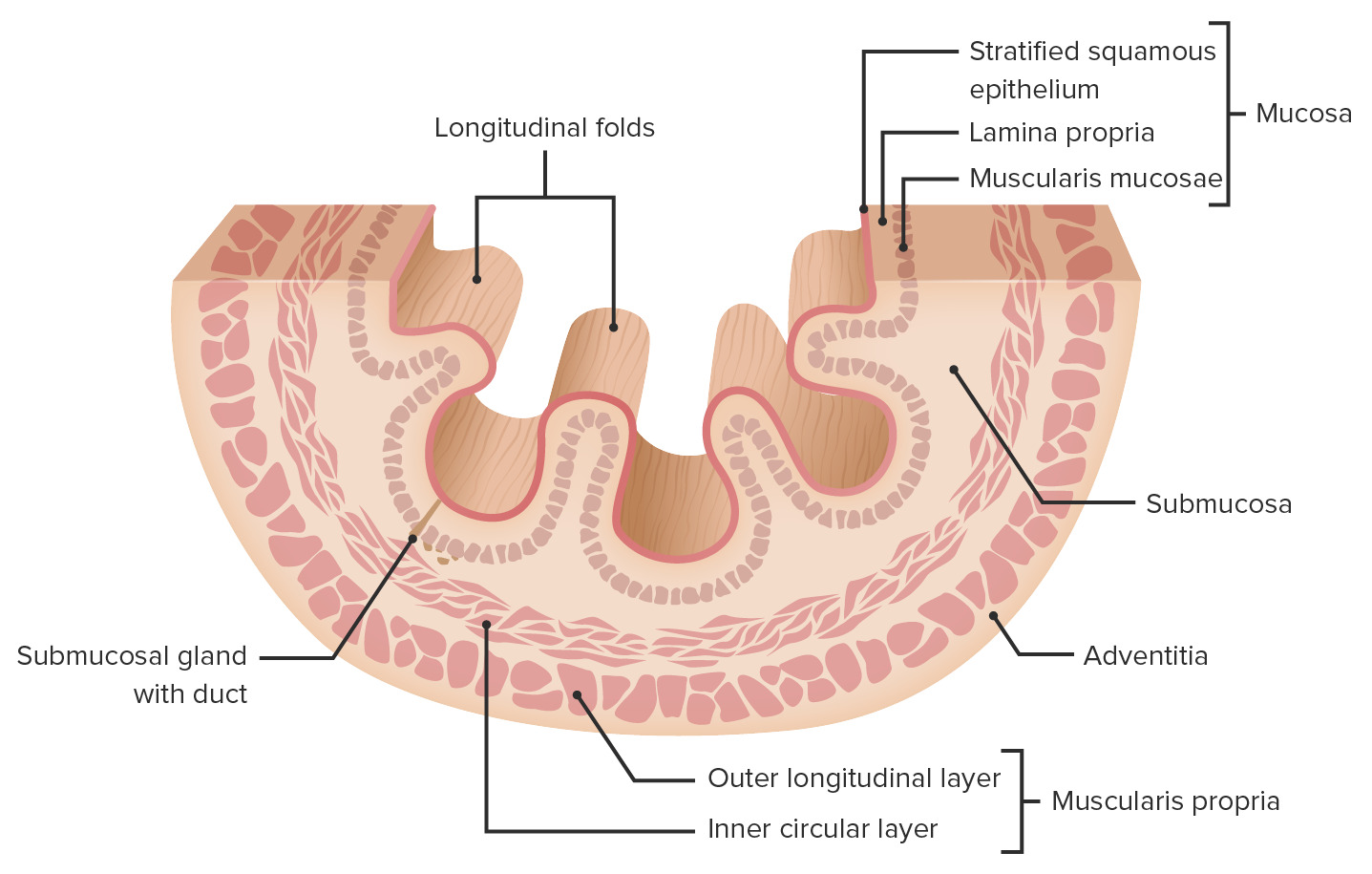Playlist
Show Playlist
Hide Playlist
Celiac Trunk
-
Slides Celiac Trunk.pdf
-
Download Lecture Overview
00:01 So now let's spend some time looking at the celiac trunk in some detail. 00:06 So here we can see we have the celiac trunk. 00:08 it's coming off the abdominal aorta, And we can see it comes off at a roundabout, the 12th thoracic vertebral level. 00:16 Just as the aorta was passed through the aortic hiatus. 00:20 It gives off three important branches. 00:23 We can see the left gastric artery, we can see the splenic artery and we can see the common hepatic artery. 00:31 The left gastric artery is going to supply the lesser curvature of the stomach and also it's going to pass up to the cardiac esophageal junction between the esophagus and the stomach. 00:43 And here we can see the left gastric passing up towards that area and giving off some of esophageal branches. 00:49 These are going to anastomose with other esophageal branches coming from the thoracic aorta directly. 00:56 As the esophagus passes down in front of the aorta, it is receiving esophagus or branches along its journey. 01:03 Here we can then see the left gastric artery passing along the lesser curvature where it's then going to meet with the right gastric artery. 01:11 And if you remember the right gastric artery is coming from the gastroduodenal artery. 01:16 Let's now have a look at the splenic artery. 01:19 The splenic artery is running along the superior and posterior aspect of the pancreas heading towards the hilum of the spleen. 01:26 And here we can see as it runs towards the spleen within the splenorenal ligament is running some splenic branches. 01:35 These branches are entering into the spleen. 01:38 Along the journey, along the superior and posterior aspect of the pancreas, it gives rise to some pancreatic branches that supply the body and the tail of the pancreas. 01:49 It also supplies superiorly some short gastric arteries that go on to supply the upper part of the body and the fundus of the stomach. 01:58 It also gives rise to a branch that supplies parts of the greater curvature and this is the left gastro-omental artery. 02:06 Anastomosing with the left gastro-omental artery, we will also have the right gastro-omental artery and hopefully you remember that that comes from the gastroduodenal artery and this forms that anastomosis around the greater curvature. 02:21 Coming from the left and the right gastro-omental arteries are some anterior and posterior branches. 02:27 These are going to supply the anterior and posterior surfaces of the stomach. 02:32 Descending inferiorly, we also have some omental branches and these paths into the greater momentum. 02:37 As you remember from the peritoneum lecture, the greater omentum hangs from the stomach and the transverse colon and these are omental branches go and supply that greater momentum. 02:48 Now let's turn our attention to the common hepatic artery. 02:52 The common hepatic artery here gives rise to a really important branch that we've heard of a couple of times before. 02:58 The gastro duodenal artery. 03:00 Once is giving off this gastroduodenal branch it then carries on towards the liver as the hepatic artery proper. 03:07 The hepatic artery proper is then going to divide into the left and the right hepatic arteries. 03:13 And these go on to supply the left and right functional lobes, respectively. 03:18 As the hepatic artery causes towards the liver, it will also give rise to the cystic artery and the cystic artery supplies the gallbladder. 03:26 Coming off, sometimes the gastric duodenal artery. 03:29 But in this diagram here, we can see it coming off the hepatic artery proper is the right gastric artery. 03:36 And remember, the right gastric artery will anastomosed with the left gastric artery around that lesser curvature. 03:43 Now, let's concentrate on the gastroduodenal artery. 03:46 You can see it gives rise to the supraduodenal artery that supplies the superior aspect of the duodenum. 03:52 And then it gives rise to the posterior superior pancreaticoduodenal artery. 03:58 So here we have the superior pancreaticoduodenal artery, but it's giving rise to a branch that heads posteriorly hence we call it the posterior superior pancreatic duodenal artery. 04:10 We'll also remember that it gives rise to the right gastro-omental with anastomoses with the left gastro-omental supplying the greater curvature of the stomach. 04:19 As we have a posterior superior pancreaticoduodenal artery, it carries on and gives rise to an anterior version. 04:26 So these superior pancreaticoduodenal arteries are coming ultimately from the celiac trunk, and they're supplying the more superior aspect of this region, both the pancreas and the duodenum around the head of the pancreas, and the duodenum. 04:42 As the gastroduodenal artery passes down is giving rise to branches both anteriorly and posteriorly. 04:49 Hence, we use the anatomical terminology to locate them. 04:52 As we continue moving inferiorly, we actually find we have inferior pancreaticoduodenal arteries, and these come from the superior mesenteric artery. 05:02 This is the anterior version. 05:04 And we also find we have a posterior version. 05:07 And these are important. 05:09 They're coming from the superior mesenteric artery, which means they're starting to supply the midgut. 05:15 And here we have the anastomosis between these inferior and superior pancreatic duodenal arteries via their anterior and posterior pairs. 05:26 So you can see that the celiac trunk is a really complicated blood vessel but gives rise to three primary branches. 05:33 The left gastric, the splenic and the common hepatic. 05:37 The left gastric will then go on to supply some of the esophagus giving some esophageal branches. 05:44 The common hepatic has lots of branches. 05:47 It gives rise to the gastroduodenal artery. 05:49 It gives rise to the hepatic artery proper. 05:52 The hepatic artery proper will then on its way to the liver give rise to the cystic. 05:57 The hepatic artery proper, once it's given rise to the cystic may well give rise to the right gastric before it then goes on to give rise to right and left hepatic arteries. 06:08 The right gastric it's important to note here runs along the lesser curvature of the stomach to anastomose with the left gastric. 06:17 The gastroduodenal artery gives rise to the superior pancreaticoduodenal artery. 06:23 And as we've seen, this has both anterior and posterior branches. 06:28 The gastricduodenal artery also gives right gastro-omental artery with the splenic artery giving rise to the left gastro-omental artery. 06:38 And these two paired arteries supply the greater curvature of the stomach. 06:43 So we can see in this diagram how the celiac trunk can actually supply both the lesser and the greater curvature of the stomach by two complex anastomoses. 06:55 The left gastric and the right gastric supplying the lesser curvature and the left and right gastro-omental arteries supplying the greater curvature. 07:04 It may be helpful to actually go away, and try and draw this diagram yourself and then come and check for the main branches. 07:11 We can also just for completeness, see coming off the splenic artery we have some short gastric arteries that supply the fundus and the superior aspects of the body of the stomach.
About the Lecture
The lecture Celiac Trunk by James Pickering, PhD is from the course Vascular Supply of the Abdomen.
Included Quiz Questions
Which artery has a branch called the gastroduodenal artery?
- Common hepatic
- Right gastro-omental
- Celiac
- Left gastric
Which artery is a branch of the splenic artery?
- Left gastro-epiploic (gastro-omental)
- Left gastric
- Right gastric
- Right gastro-omental
- Cystic
Which organ is not supplied by the celiac trunk directly or by any of its branches?
- Distal half of the duodenum
- The inferior part of the esophagus
- Stomach
- Proximal half of the duodenum
- Pancreas
Customer reviews
5,0 of 5 stars
| 5 Stars |
|
5 |
| 4 Stars |
|
0 |
| 3 Stars |
|
0 |
| 2 Stars |
|
0 |
| 1 Star |
|
0 |






